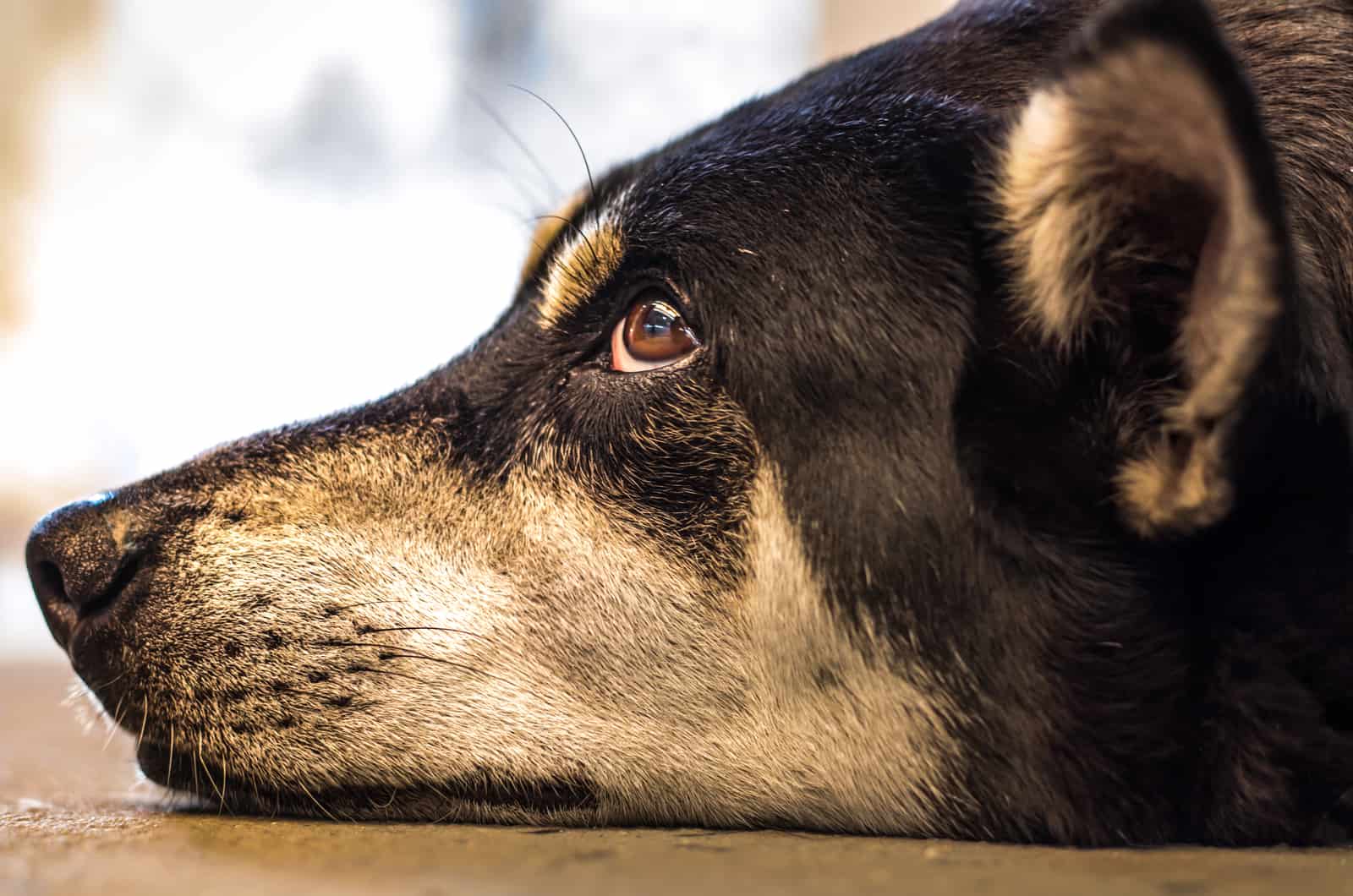As pet parents, few things cause us as much worry and concern as when our furry friends get sick. And, nothing gets us moving quite as swiftly as the sound of a dog about to throw up. It’s all part of the ‘fun’ of owning a pooch!
Thankfully, when they do get sick, it isn’t usually serious. Even so, there is a chance that your puppy’s life might be at risk. Because of this, you must be aware of the possibilities so that you can assess the situation and take the necessary action.
Many anxious dog owners head online, Googling things like, My dog is gagging and not throwing up! This is a classic example of something that is probably not serious, but there is a chance that you’ll need to act quickly and get your pooch to the vet.
Gagging is a reflex action in the throat and diaphragm, usually in reaction to something nasty, and it is often (but not always) followed by vomiting. You pretty much know when your dog vomits, and that’s unpleasant enough. But, when you find your dog gagging but nothing follows, you might wonder what’s up. To help you understand what might be going on, we’ve compiled a list of six possible causes.
First, we’ll add a quick disclaimer to say that there is no substitute for professional veterinary advice. The information provided here is purely for general information only. Anyone reading this article whose dog is gagging but not throwing up right this very moment should stop right away and call their vet!
1. A foreign Object.

If someone Googled, why is my dog gagging but not throwing up?, the first thing they need to do is check that the dog isn’t choking on something. This is usually referred to as a foreign object or a foreign body. It could be anything; a twig, a piece of rawhide chew, a piece of a toy, a bone, a coin, and so on.
The sound of a dog coughing is often similar to the sound they make when trying to vomit, and it can be confusing. Still, it’s important to try and learn the difference between these noises as your dog’s life may depend on it.
Most dog owners know that their beloved pets eat stuff they shouldn’t. And, sometimes this doesn’t end well. If your dog has a foreign object lodged in its throat, it may sit there for a few hours or even days if it isn’t causing too much of an obstruction.
However, you may notice your dog retching and gagging but unable to produce anything except possibly some white foam. The object sometimes slips down and is either digested, or the dog will poop it out later.
Occasionally, it gets more serious. Dogs frequently become distressed and paw at their mouth. They will refuse their food and become depressed. You may even notice that they are reluctant to bend their neck as this causes further discomfort.
In these cases, it is likely that the esophagus wall has been damaged, which may require surgery. Removing the object can be tricky, depending on what it is. Ideally, it will be removed by using a tube passed through the mouth, or it may even be broken down. Sometimes, the object is pushed down into the stomach and surgically removed from there. In extreme cases, the vet will have to remove it surgically from the dog’s throat by making an incision in the neck, but this is a risky procedure.
There are practical ways of limiting the risk of your dog choking:
• Never give them cooked bones as they splinter into small pieces that can lodge in the throat.
• Never give them small bones that present a choking hazard.
• Don’t give them cheap toys or anything that can be easily chewed into small pieces. Always make sure the toys are too big to be swallowed whole.
• Watch your dog (as much as possible!) when out for a walk to ensure that it doesn’t scavenge or decide to chew on something that it shouldn’t.
• Avoid using rawhide chews. If you do give this to your dog, then take it away once it has been chewed down into pieces that might be swallowed.
It’s all about keeping them as safe as possible, and part of being a responsible dog owner.
2. Kennel Cough.

The common cold that brings so much misery to humans is caused by many different viruses. The same goes for kennel cough in dogs, which is why it has several different names. The main culprit is the bacteria Bordetella bronchiseptica, which is why you will hear kennel cough referred to as Bordetella or Bordetellosis. This sickness is also called canine infectious tracheobronchitis, and it is highly contagious. Most infected dogs also contract viruses at the same time, such as canine reovirus, adenovirus, parainfluenza, canine herpes, and distemper.
This respiratory infection, a form of bronchitis, spreads rapidly in places where dogs gather in large numbers, such as in boarding kennels (hence, the name!), dog parks, training groups, or the show ring.
It is passed on through droplets of moisture from an infected dog’s nose or mouth, either through the air or when deposited on surfaces, such as a water bowl or a food bowl, or maybe a chew toy. It can easily be passed when dogs touch noses in greeting.
Dogs can contract this infection more easily if they are exposed to dust particles, cigarette smoke, cold temperatures, crowded areas with poor ventilation, and excessive stress (especially related to long-distance travel). All of these conditions can weaken the mucus lining in their throat that provides natural protection against bacteria and viruses.
How is kennel cough relevant to someone who says ‘my dog is gagging and not throwing up’? The answer lies in the symptoms. Dogs with kennel cough will experience the following:
• A slight fever.
• A runny nose.
• Sneezing.
• A loss of appetite.
• A lack of energy.
• A hacking cough that can sound like a goose honking.
This last symptom is a giveaway, telling you that your dog has most likely picked up kennel cough. Dog owners often hear their dogs coughing and gagging. It’s only natural to be alarmed and concerned as this can sound really bad. This happens because the larynx and trachea are inflamed, causing the dog a lot of discomfort and irritation.
In the majority of cases, kennel cough should disappear after about three weeks. This might stretch to six weeks if your dog is elderly and/or has other medical issues.
You can help your furry pal by keeping it in a well-ventilated area with high humidity, and by using a harness instead of a leash and collar as these will put pressure on its windpipe.
To speed up the healing process, your vet may prescribe antibiotics. Kennel cough vaccines are available, but the value of these is debatable because there are so many different viruses and bacteria that cause the infection. They certainly won’t be effective in treating a dog that has already contracted the infection.
3. Hairballs.

We know what you’re thinking: I thought only cats get hairballs?
Dogs get them, too, but not as often as they don’t lick themselves every day like cats do (unless there’s something wrong!).
Cats get rid of these in their own special, gross way. When dogs groom themselves, particularly long-haired breeds, they sometimes swallow hair. Unlike cats, they rarely cough it up. Instead, the hair clumps together in the digestive system.
The danger here is that if the hairball gets too big, it can cause a blockage in the dog’s stomach. This is bad for several reasons: your dog may become dehydrated and not be able to absorb fluids properly, they may become constipated, or even have diarrhea, and they will probably lose their appetite.
More importantly, for the sake of people who say my dog is gagging and not throwing up, you will probably notice your dog dry heaving. The poor pooch will make all kinds of retching sounds, but nothing will come up no matter how hard they try.
Other signs include increased shedding in long-haired dogs, and you’ll see them licking themselves more. You might also find that they chew their fur.
In extreme cases, especially when the hairball causes an intestinal blockage, surgery is the only option. However, it’s more usual for the vet to prescribe laxatives that will help to ease the hairball through the digestive system. If you suspect that your dog has a hairball, you might want to try a home remedy, such as putting olive oil in its food or giving it fish oil supplements. Canned pumpkin is also a good choice as this can help to break down the hairball.
As always, prevention is better than cure, so here’s how to cut the risk of hairballs.
• Regular brushing – frequent grooming gets rid of loose hair. A de-shedding tool is useful for removing dead fur from the undercoat, and this stops the dog from swallowing the hair when it licks its coat.
• Trimming – trimming long hair every three or four months will keep it shorter. Short hair passes through the gut more easily.
• Keep them hydrated – make sure that your dog drinks plenty of water. It’s good for them anyway, but it also ensures that the intestinal lining doesn’t become dry as this can allow fur to accumulate.
• Nutrition – always use good-quality dog food that is rich in essential vitamins and minerals, but especially proteins and omega-3 fatty acids. These keep the coat healthy and strengthen the hair follicles, meaning that the roots keep hold of the hairs longer. Stronger, healthier fur won’t be pulled out as easily if the dog does lick its coat.
4. Bloat.

Now, we’re moving on to a more serious condition that may be life-threatening.
Bloat, otherwise known as Gastric Dilatation-Volvulus (GDV), is a bit of a mystery, but it is usually found in large, deep-chested dog breeds such as Great Danes, German Shepherds, and Labrador Retrievers, although all breeds can experience this condition.
It often occurs shortly after eating or drinking, generally when the dog has overindulged. It also seems to be more likely if the eating or drinking takes place just before or after strenuous exercise.
What makes GDV such a serious matter is that the dog’s stomach swells up with gas (or sometimes liquid) and then it starts to twist around on itself. This doesn’t always happen, but when it does, it is painful, but that’s not the main problem. The twisting action restricts the blood flow to vital organs. If this happens long enough, they fail to function properly and the tissue starts to die. In some cases, the pancreas starts to produce toxins as it is starved of oxygen. These toxins flood into the dog’s system, causing toxic shock syndrome.
As you can see, GDV is pretty serious! So, for people who say my dog is gagging but not throwing up, it’s handy to know what else to look out for. Here are some of the symptoms you might notice:
• A hard or swollen stomach – check this first as it’s the most obvious sign. The stomach will be visibly swollen and firm to the touch. Don’t hesitate if you spot this… contact the emergency vet immediately.
• Accelerated heart rate – check your dog’s pulse if you can. If they do have GDV, it will be much higher than normal.
• Pale gums – if you pull back your dog’s lips and notice that they aren’t as pink as usual, this is a sign of anemia or blood loss, but in this case, it shows that the blood flow is restricted.
• Rapid breathing – your dog will be panting hard, even if they haven’t exerted themselves.
• Lethargy – is your dog having trouble standing? Do they seem weak, or unwilling to play or exercise? It’s not an issue by itself, but when combined with the other symptoms, it could be a sign that they have bloat.
• White foam – this can be alarming, especially as foaming at the mouth is traditionally connected with rabies. Use a flashlight if necessary and look inside your dog’s mouth. If you do spot white foam, this is another sign of GDV.
• Drooling – most dogs drool at some point, and some breeds are infamous droolers! We’re talking about an excessive amount here. Drooling is normal, but if there’s much more than usual, and you’ve seen all the other symptoms, then it’s likely that your dog has GDV.
• Gagging without vomiting – this is the clincher. If this is happening along with all of the above, then your dog is in danger.
The seriousness of this condition should not be underestimated. In the past, the prognosis for dogs with bloat was grim. It can still be fatal, so you need to act fast.
However, you need to remain calm. Your furry pal needs you more than ever, and if you panic, they will pick up on your emotions.
The first thing to do is get to the vet. They will stabilize your dog and make it as comfortable as possible by using pain medication. They will then monitor the dog’s heart rate and blood pressure, decompress its stomach, and perform surgery to twist it back into position if necessary. Once this is done, they will assess any damage to the internal organs and take appropriate action.
Preventative measures include the following:
• Avoid using an elevated food bowl as these are known to contribute to bloat.
• Make sure your dog eats slowly, and feed it several small meals rather than one or two big ones.
• Avoid letting it exercise an hour before or after eating.
• Reduce carbs, and use food that is at least 30% protein and 3% crude fiber.
• Use probiotics and add enzymes, such as Prozyme, to your dog’s food to reduce gas.
• Avoid foods that have citric acid or fats as the first four ingredients.
• Always give them fresh water, but don’t let them drink too fast.
It’s a good idea for all dog owners to be aware of these symptoms so they can recognize them. Hopefully, you’ll never need this information, but it might just save your dog’s life one day.
Read More: Why Does My Dog Fart So Much?
5. Laryngeal Paralysis.
The larynx is a handy thing. This muscle regulates the junction between the trachea and the esophagus (windpipe and food pipe) at the back of the throat to allow air to flow through and to stop food or drink from entering the airways.
Although dogs are much different than humans in terms of anatomy, they also have a larynx.
Sadly, as certain dogs get older, the larynx becomes weakened and fails to fully open, restricting the airflow in and out of the lungs.
Although any breed can suffer from this condition, it is mostly seen in large breeds; Labradors and Golden Retrievers in particular. Middle-aged or older dogs are more susceptible to laryngeal paralysis than younger ones.
This condition usually progresses as the dog ages, meaning that you may not notice it until it gets much worse. Mild cases are easy to miss. You might notice that your dog is breathing hard, but they probably won’t be in any distress.
Hot weather or stress can worsen the symptoms, and in severe cases, the dog will become lethargic and experience breathing difficulties. They will pant excessively, and will often collapse. This is relevant to our main topic, my dog is gagging and not throwing up because your dog will make an odd, rasping bark. His voice will change, and it might sound like he’s choking or trying to vomit.
This condition has been linked with hypothyroidism, although in most cases, no cause can be found.
Your vet will take X-rays of your dog’s neck and chest, as well as do blood work. Your dog will be lightly sedated while the vet examines its larynx.
If the case is severe enough, your vet will recommend surgery, called a laryngeal tieback. This will solve the breathing difficulty, but the procedure opens one side of the larynx permanently. Apart from the obvious choking risk, food or liquid can enter the windpipe and head into the lungs, leading to aspiration pneumonia, which causes difficulty breathing and secondary infections.
Sadly, there’s not much you can do to prevent this condition. Dogs are treated on a case-by-case basis to evaluate the severity, and appropriate treatment is then given.
6. Collapsing Trachea.

Photo from: @tinka_bolonka
Problems relating to the windpipe in dogs are usually congenital, meaning that the dog is born with weak cartilage in the trachea. However, dogs with heart disease, chronic respiratory problems, Cushing’s disease, and obesity, along with those that have been exposed to cigarette smoke, will have an increased risk.
As the dog ages, the ring of cartilage grows weaker, and eventually flattens out and collapses completely. This causes the airways to narrow significantly, leading to breathing problems. Dogs get progressively worse, usually showing signs of the condition around the age of 6 years.
The problem generally affects toy or miniature breeds, with Chihuahuas, Toy Poodles, Yorkshire Terriers, and Pomeranians affected more than any other.
Some of the symptoms might sound familiar:
• Rapid, labored breathing.
• Lack of energy.
• Fainting or collapsing.
• Strange, honking cough.
• Blue tinge on the gums due to lack of oxygen in the blood.
As you might guess, the honking cough links with our main theme, my dog is gagging and not throwing up. The dog sounds very much like it is trying to vomit, but nothing is coming out.
Mild to moderate cases are treated with medication, such as bronchodilators, to open the airways, along with anti-inflammatory steroids, cough suppressants, and sedatives. None of these medications will cure the condition, but they will allow the dog to live a fairly normal life.
Severe cases usually require surgery to install a stent or a plastic ring to keep the airway open.
You can help by avoiding smoking or using aerosols near your dog, as well as by using a harness instead of a collar and a leash. You’ll also need to keep an eye on your dog’s weight and avoid them becoming obese.
In Conclusion
As we pointed out at the start, it’s essential to get advice from a pet health specialist if you suspect that your precious pooch is sick.
What we’ve done here is give you a few tools to help you make an initial assessment of your pet’s condition. If you have a better grasp of the situation, you’ll be able to pass on more detailed information to the vet, which will possibly help them reach a speedy diagnosis and begin treatment sooner.
No dog lover wants to think about their best friend getting sick, but being fully prepared for all eventualities is just another way of proving that you care. In the future, if your dog keeps gagging, but they don’t vomit, you’ll be able to keep your head and get the right help.
Also, when you hear someone else say, my dog is gagging and not throwing up, you’ll be able to tell them exactly what to look out for!
Read Next:
• Dog Throwing Up White Foam: Upset Stomach Or Something Else?
• Help! My Dog Sounds Congested, What Should I Do?
• How To Make Dog Throw Up After Eating Chocolate















